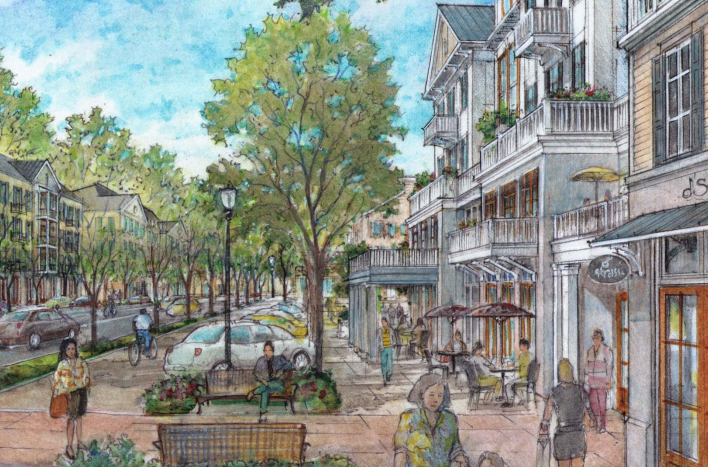Southampton Town adopts revitalization plan for Riverside

After nearly a year in the making, Southampton Town officially has a plan in place to revitalize Riverside — the area’s most economically-stressed and blighted neighborhood.
The Southampton Town Board unanimously approved the Riverside Revitalization Action Plan at its Tuesday meeting, Supervisor Anna Throne-Holst said in an interview.
The plan, called “Riverside Rediscovered,” features an overlay district with zoning changes property owners could opt into that would allow them to build higher density developments in certain areas. One of stipulations to receive the new zoning is hiring local residents.
“It’s such an attractive plan and [it’s] going to create a fundamental change to this area,” Ms. Throne-Holst told the News-Review. “It’s a little miracle and has been a labor of love for those of us who have envisioned this and have been a part of the process.”
In December 2013, the town selected Renaissance Downtowns, a for-profit real estate development company based in Plainview, to draft the plan. While the town isn’t paying Renaissance Downtowns for the study, the company’s profits would come from developing the land.
The public-private approach has Councilman Brad Bender believing it will be more successful than previous efforts.
“This is an action plan — it isn’t another study that’s going to sit on a shelf,” he said. “We expect that within the next year we’ll see a shovel in the ground somewhere in Riverside.”
Ms. Holst said once environmental studies are complete, town officials, various community leaders and Renaissance Downtowns representatives will work together to attract potential developers to the area.
Sean McLean, a Flanders resident and vice president of planning and development with Renaissance Downtowns, couldn’t immediately be reached for comment.
There are seven zoning categories featured for the Riverside Overlay District. In general, the closer a property is located to the traffic circle, the more density allowed.
For example, a hamlet center featuring mixed-use development of apartments above business spaces has been proposed for the areas located within a 5-minute walking distance to the traffic circle. This zoning, called “Riverside Hamlet Center,” also calls for “hospitality, cultural and entertainment uses” and provides the most density of any of the zoning categories, according to the plan.
Zoning for properties located within a 10-minute walk to the traffic circle is mostly described in the plan as residential neighborhoods “without the hustle and bustle of the hamlet center.”
A 15-minute walk from the traffic circle is where the plan calls for a “Riverside Suburban District.” Under that zoning, single-family neighborhoods would be preserved. The proposal also calls for indoor recreation, a community resource center and daycare facilities in this area.
In addition, a “Riverside Gateway District” is proposed along County Road 104. This area would feature an artistic sign to welcome visitors.
Some of the features included in the “Riverside Waterfront District” and “Riverside Parkland” categories include a boardwalk, trails and enhanced access to the Peconic River.
The plan also calls for a waterfront promenade with restaurants and an area for the popular “Waterfire” show to take place in the river several times per month.
Mr. Bender said his favorite part of the action plan is the commitment to increasing physical and visual access to the Peconic River and enhancing parkland so visitors can enjoy hiking trails and sightseeing wildlife.
“The icing on the cake is the Waterfire,” he said. “Once we have the access, that piece will be a big draw.”
Vince Taldone, the president of the Flanders, Riverside and Northampton Community Association, said he believes the plan is a success because Renaissance Downtowns made public presentations and conducted Internet polls and door-to-door surveys in order to gain feedback from throughout the neighborhood.
In addition, the town had already done various studies, which Mr. Taldone said was useful in drafting the latest proposal.
Mr. Taldone, a former city planner, said he’s never seen such a thorough land-use plan in his career.
“I’m just so thrilled with the group of elected officials that pulled this together,” he said. “I’m hoping we can keep that going. The hard part is over. Now there’s an opportunity for a developer to make money without railroading the community.”
Mr. Taldone and Mr. Bender agreed the Budget Host East End could benefit the most by opting into the Riverside Overlay District.
General manager Henry Karim — whose father, Allah Rana, has owned the hotel for about 16 years — said although the proposed plan aims to help businesses, he believes a sewage treatment facility is needed more than anything else.
“Nothing can be done with the sewage facility,” he said. “It’s exciting everyone is talking about future plans, but, for businesses, we’re stuck where we are without sewers.”
Ms. Throne-Holst said a sewer study has been completed and plans are moving forward to build a pedestrian bridge to link Southampton and Riverhead towns over the Peconic River.
“The community has been there from the beginning and a real sense of ownership of the plan,” she said. “I believe people will look back at this as a great process and a real job creator.”








